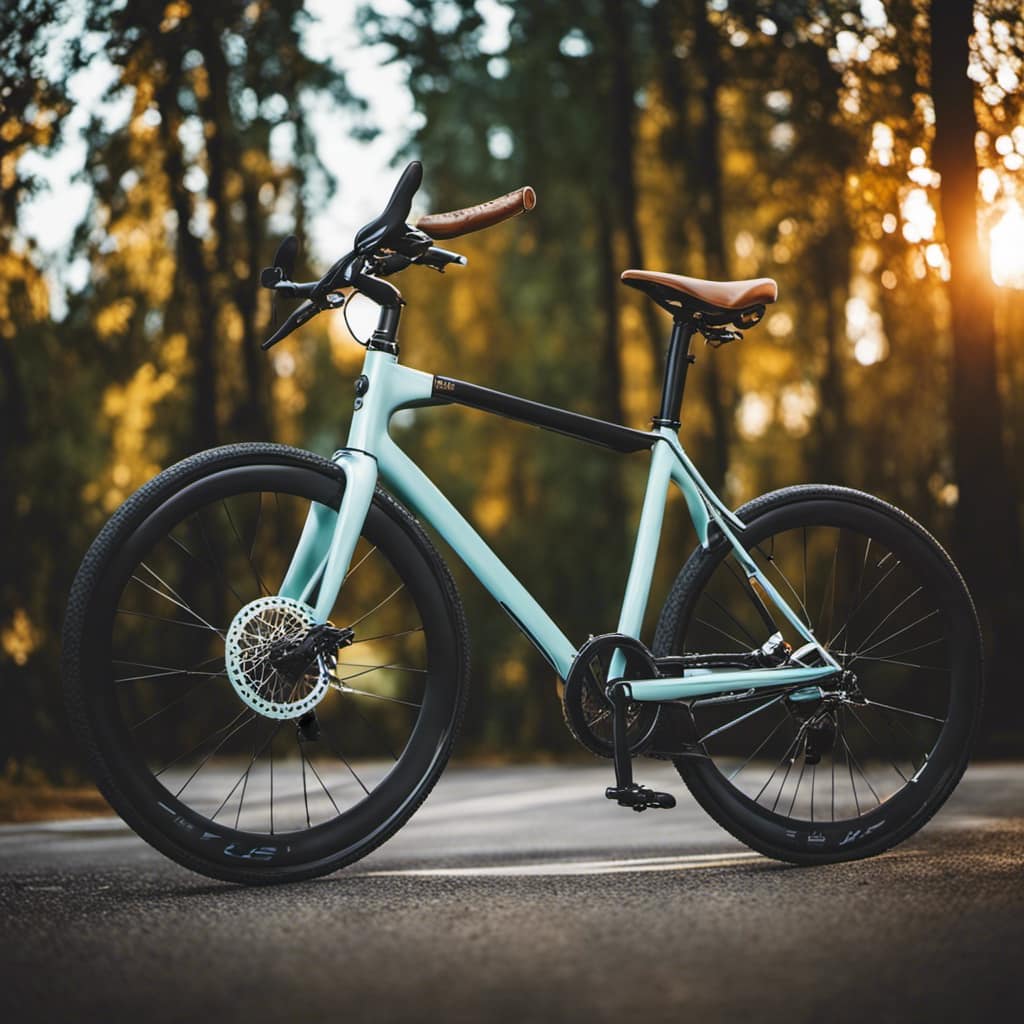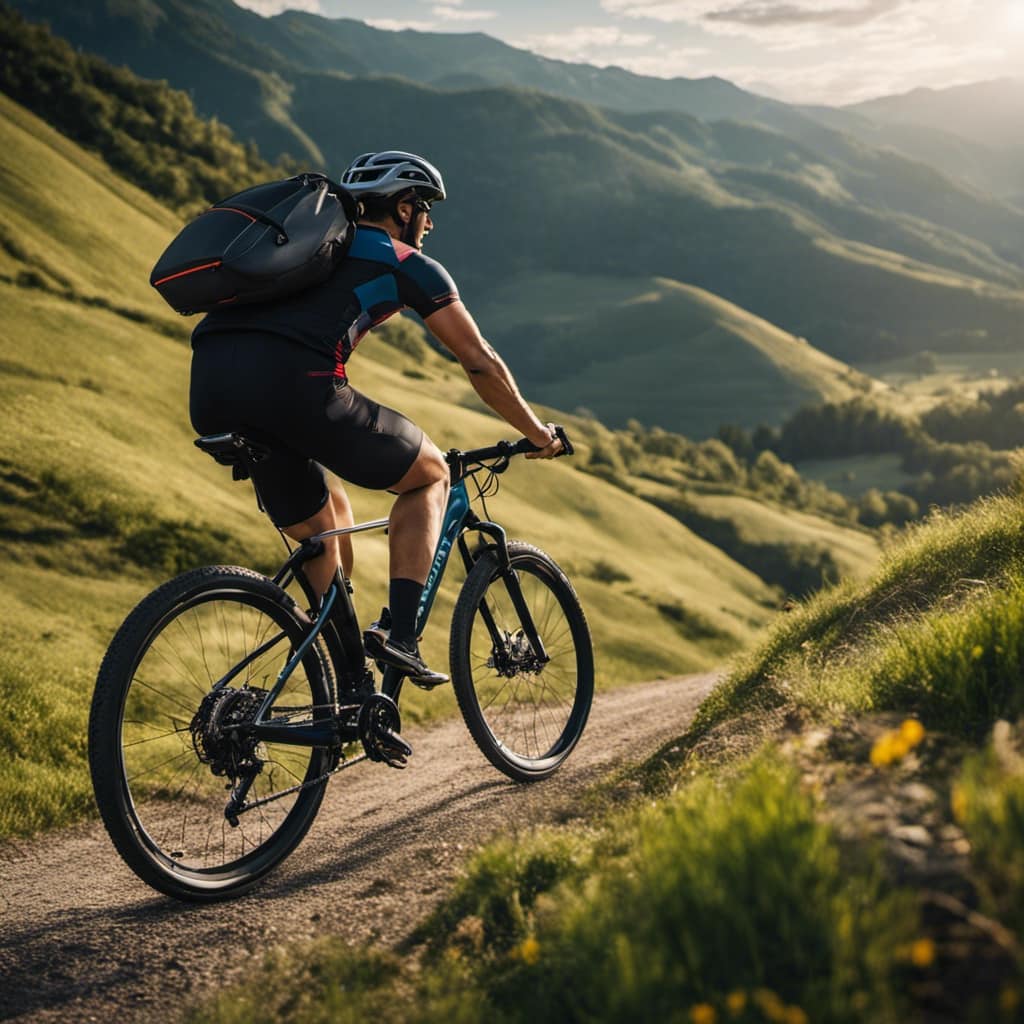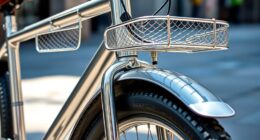Are you tired of spending money on bike repairs? We’ve got you covered!
In this article, we’ll share 12 must-know maintenance tips for hybrid bikes. From tire maintenance to brake adjustments, chain lubrication to gear shifting optimization, we’ll show you how to keep your bike in top shape.
With our technical and precise instructions, you’ll be able to take charge of your bike’s maintenance and enjoy the liberation of a smooth and hassle-free ride.
Let’s get started!
Key Takeaways
- Regularly check tire pressure and inspect tires for wear or damage
- Use proper lubricant and regularly lubricate the chain
- Check sag, adjust rebound damping, and fine-tune compression damping for suspension
- Proper spoke tension and wheel flexibility are crucial for a comfortable ride
Tire Maintenance
We need to regularly check the tire pressure of our hybrid bikes to ensure optimal performance. Maintaining the correct tire pressure is crucial for a smooth and safe ride. Low tire pressure can result in increased rolling resistance, making it harder to pedal and reducing overall efficiency. On the other hand, overinflated tires can lead to a harsh ride and increased risk of punctures.
To avoid these issues, it’s recommended to check the tire pressure at least once a week. Use a reliable pressure gauge to ensure accuracy. Additionally, it’s important to inspect the tires for any signs of wear or damage. If the tires are worn out or have punctures that can’t be repaired, tube replacement may be necessary.
Regular tire maintenance won’t only improve performance but also prolong the lifespan of your hybrid bike.
Brake Adjustments
To ensure optimal braking performance, it is essential to regularly adjust our hybrid bike brakes. Proper brake adjustments not only improve stopping power but also ensure rider safety. Two key aspects of brake adjustments are brake pad replacement and cable tension adjustment. Brake pads wear down over time and need to be replaced when their thickness reaches the minimum recommended level. Cable tension adjustment involves fine-tuning the tension in the brake cables to ensure a responsive and smooth braking action. This can be done using the barrel adjuster located on the brake levers. Regularly inspecting and maintaining our brake pads and cables will help us enjoy a safe and efficient riding experience.
| Brake Pad Replacement | Cable Tension Adjustment |
|---|---|
| Check pad thickness regularly | Use barrel adjuster on brake levers |
| Replace when thickness reaches minimum level | Fine-tune tension for responsive braking |
| Follow manufacturer’s guidelines | Ensure smooth braking action |
| Ensure proper alignment | Regularly inspect and maintain |
| Test brakes after replacement | Enjoy safe and efficient riding experience |
Chain Lubrication
When it comes to chain lubrication, it’s crucial to use the proper lubricant that’s specifically designed for bike chains. Regular lubrication is necessary to keep the chain running smoothly and prevent unnecessary wear and tear.
Signs of inadequate lubrication include a noisy chain, difficulty shifting gears, and visible rust or dirt buildup.
Proper Lubricant for Chains
How often should we apply chain lubricant to our hybrid bikes?
Proper chain lubrication is essential for maintaining the performance and longevity of our bikes. In wet conditions, it’s recommended to use the best lubricants specifically designed for such conditions. These lubricants are formulated to resist water and provide optimal protection against rust and corrosion. They also ensure smooth and efficient shifting, minimizing friction and wear on the drivetrain components.
On the other hand, dry lubricants offer several benefits. They’re less prone to attracting dirt and debris, keeping the chain cleaner for longer periods. Dry lubricants also provide a quieter and smoother ride.
Regardless of the lubricant chosen, it’s important to apply it regularly, especially after riding in wet conditions or when the chain appears dry. Proper chain lubrication is key to ensuring a reliable and enjoyable biking experience.
Frequency of Lubrication
We should regularly apply chain lubricant to our hybrid bikes, both before and after riding, in order to maintain optimal performance and prevent unnecessary wear and tear. Proper lubrication is crucial for the smooth and efficient operation of the bike’s drivetrain system.
Here are some key points to consider regarding the frequency of lubrication:
-
Regular Lubrication: It’s recommended to lubricate the chain every 100-150 miles or every 2-3 weeks, depending on your riding conditions and intensity.
-
Visual Inspection: Regularly check the chain for signs of inadequate lubrication, such as dryness, rust, or dirt accumulation.
-
Smooth Operation: If you notice any squeaking, grinding, or resistance while pedaling, it may be a sign that the chain needs lubrication.
Signs of Inadequate Lubrication
Noticing a dry, sticky chain and experiencing increased resistance while pedaling are signs of inadequate lubrication, but applying chain lubricant regularly and correctly will help prevent these issues. Inadequate lubrication causes friction between the chain and the gears, leading to poor performance and potential damage to the drivetrain components. When the chain lacks proper lubrication, it becomes less efficient at transferring power from the pedals to the wheels, resulting in increased resistance and a less smooth ride. Additionally, inadequate lubrication can accelerate wear and tear on the chain and gears, leading to premature failure and costly replacements. To ensure optimal performance and longevity of your hybrid bike, it is essential to keep the chain properly lubricated. In the table below, we outline the effects of inadequate lubrication on your bike:
| Effects of Inadequate Lubrication |
|---|
| Increased resistance while pedaling |
| Poor shifting performance |
| Increased wear on chain and gears |
| Potential damage to drivetrain components |
Gear Shifting Optimization
To maximize performance and efficiency, we recommend regularly adjusting the gear settings on your hybrid bike. Proper gear shifting techniques and gear ratio adjustment can greatly enhance your riding experience.
Here are some tips to optimize your gear shifting:
-
Understand your bike’s gear range: Familiarize yourself with the number of gears and the gear ratio range your bike offers. This knowledge will help you make informed decisions while shifting.
-
Smooth shifting: Shift gears smoothly and gradually, avoiding sudden and forceful movements. This will prevent damage to the drivetrain and ensure a seamless transition between gears.
-
Anticipate terrain changes: Adjust your gears in advance when approaching uphill or downhill sections. Shifting to a lower gear before a climb will make pedaling easier, while shifting to a higher gear before descending will allow for a faster and more controlled ride.
Suspension Tuning
Let’s now turn our attention to suspension tuning, an essential aspect of maintaining a hybrid bike’s performance. By finding the optimal suspension settings, we can ensure a smooth and comfortable ride.
Additionally, we’ll address common suspension issues and provide tips on how to resolve them effectively.
Optimal Suspension Settings
We should start by adjusting the suspension settings on our hybrid bikes for optimal performance. Proper suspension maintenance ensures a smooth ride and prevents unnecessary wear and tear on our bikes.
Here are some tips for troubleshooting and optimizing our suspension settings:
-
Check sag: Measure the sag, which is the amount the suspension compresses under our weight when sitting on the bike. Adjust the air pressure or preload to achieve the recommended sag percentage.
-
Rebound damping: Adjust the rebound damping to control how quickly the suspension returns to its original position after compression. This will help maintain traction and stability.
-
Compression damping: Fine-tune the compression damping to control how the suspension handles impacts. Increase compression damping for a firmer ride and decreased bobbing, or decrease it for a softer ride.
Common Suspension Issues
After addressing optimal suspension settings, we can now delve into common suspension issues and how to tune them for our hybrid bikes.
One common issue is sag adjustment, which refers to the amount of travel your suspension settles into when you’re sitting on the bike. To adjust sag, start by measuring the distance between the o-ring on your fork or shock and the seal. Ideally, the sag should be around 25-30% of the total suspension travel. If it’s too high or too low, you can adjust the air pressure or add or remove air tokens to achieve the desired sag.
Another common issue is rebound tuning, which controls how quickly your suspension returns to its original position after being compressed. Adjusting rebound can help improve control and prevent your bike from feeling too bouncy or sluggish. By experimenting with the rebound adjustment knob on your fork or shock, you can find the right setting for your riding style and terrain.
With proper sag adjustment and rebound tuning, you can optimize your hybrid bike’s suspension performance.
Now, let’s move on to the next section about frame cleaning and inspection.
Frame Cleaning and Inspection
Before starting the process of frame cleaning and inspection, it’s important to gather the necessary tools and supplies. Here are some essential items you’ll need:
-
Soft microfiber cloth: This will help prevent scratching the frame while cleaning.
-
Mild soap or bike-specific cleaner: Avoid harsh chemicals that can damage the frame’s finish.
-
Water: Use a bucket or hose to rinse off the frame after cleaning.
-
Frame protection products: Apply a frame wax or polish to protect against rust and maintain a glossy finish.
-
Rust prevention spray: Regularly spray vulnerable areas, such as the bottom bracket and seat tube, to prevent rust from forming.
-
Inspection tools: Use a flashlight and magnifying glass to inspect the frame for cracks, dents, or loose components.
Wheel Truing
When it comes to maintaining a hybrid bike, one important aspect to pay attention to is wheel truing. Proper alignment of the wheels is crucial for a smooth and efficient ride. To achieve this, there are specific tools designed for wheel truing, such as a spoke wrench and a truing stand.
However, it’s essential to be aware of common truing mistakes that can lead to further damage if not addressed correctly.
Importance of Alignment
We understand the importance of alignment, or wheel truing, in maintaining the performance of our hybrid bikes. Proper wheel alignment ensures that the wheels spin smoothly and evenly, reducing friction and improving overall efficiency. Additionally, frame alignment is crucial to ensure that the bike’s structure remains stable and balanced, preventing unnecessary stress on the components.
Here are three key reasons why alignment is important for our hybrid bikes:
-
Enhances Handling and Stability:
- Proper wheel alignment improves the bike’s handling, allowing for better control and maneuverability.
- Frame alignment ensures that the bike stays balanced, reducing the risk of wobbling or veering off course.
-
Prevents Premature Wear and Tear:
- Misaligned wheels can cause uneven tire wear, leading to frequent replacements.
- Frame misalignment can put strain on the bike’s components, increasing the risk of damage and costly repairs.
-
Maximizes Efficiency:
- When the wheels are properly aligned, energy transfer from pedaling is optimized, allowing for a smoother and more efficient ride.
- Correct frame alignment ensures that the bike moves straight and true, minimizing energy loss through unnecessary movements.
Tools for Wheel Truing
As we delve into the topic of wheel truing, it’s essential to familiarize ourselves with the tools necessary for this maintenance task.
Wheel alignment and spoke tension are crucial factors in ensuring a smooth and safe ride on your hybrid bike. To achieve proper wheel alignment, a spoke wrench is a must-have tool. This wrench allows for precise adjustments to the tension of each spoke, enabling you to align the wheel accurately.
Additionally, a truing stand is highly recommended for wheel truing. This stand securely holds the wheel in place, providing stability and ease of access for adjustments. It allows you to identify any irregularities in the wheel’s alignment and make the necessary corrections.
Common Truing Mistakes
One of the most common mistakes we make when truing wheels is tightening the spokes too much, resulting in an imbalanced and unstable ride. To avoid this, it’s crucial to find the optimal tension for each spoke, ensuring a well-aligned and sturdy wheel.
Here are three common truing mistakes to be aware of:
-
Over-tightening: Applying excessive force to the spokes can cause the wheel to become overly rigid, leading to a harsh and uncomfortable ride. It’s essential to strike a balance between spoke tension and wheel flexibility.
-
Neglecting lateral truing: Focusing solely on radial truing (adjusting the roundness of the wheel) while neglecting lateral truing (centering the wheel between the brake pads) can result in poor braking performance and uneven wear on the brake pads.
-
Ignoring optimal suspension settings: Failure to adjust the suspension settings according to the rider’s weight and riding style can affect the wheel’s true and create unnecessary stress on the spokes. It’s important to find the optimal suspension settings for a smoother and more controlled ride.
Pedal and Crank Maintenance
During our regular bike maintenance routine, we should take the time to inspect and clean the pedals and crank. Proper pedal maintenance is crucial for a smooth and efficient ride. Inspecting the pedals for any signs of wear or damage is essential. If the pedals are worn out or not functioning properly, it may be necessary to replace them.
On the other hand, the crank is responsible for transferring the power from your legs to the pedals. It’s important to ensure that the crank is securely attached and functioning smoothly. Regular cleaning and lubrication of the crank will help maintain its performance and longevity.
Handlebar and Stem Alignment
Let’s start by checking the handlebar and stem alignment to ensure that they’re properly aligned and functioning correctly. Proper alignment is crucial for a comfortable and safe ride. Here are some important maintenance tips for handlebar and stem alignment:
-
Handlebar grip replacement:
-
Regularly inspect the handlebar grips for signs of wear and tear.
-
Replace the grips if they’re loose, torn, or damaged.
-
Choose grips that provide a firm and comfortable grip for better control.
-
Stem length adjustment:
-
Evaluate the stem length to ensure it suits your riding style and body position.
-
Adjust the stem length if needed to achieve a comfortable riding posture.
-
Consult a professional bike fitter or mechanic for assistance if unsure.
Ensuring your handlebar and stem are aligned and functioning properly enhances your riding experience.
Now, let’s move on to the next section about seatpost and saddle care.
Seatpost and Saddle Care
To ensure optimal comfort and performance, we need to pay attention to the care and maintenance of our seatpost and saddle.
Proper seatpost maintenance is crucial for a smooth and enjoyable ride. Regularly inspect the seatpost for any signs of damage or corrosion. Clean it thoroughly with a mild soap and water solution, and apply a light coating of lubricant to prevent rust.
It’s also important to check the seatpost height and adjust it accordingly to ensure proper leg extension while pedaling.
When it comes to saddle selection, consider factors such as your riding style, body type, and personal preferences. Choose a saddle that provides adequate support and cushioning, and make sure it’s properly aligned and tightened on the seatpost.
Taking care of your seatpost and saddle will enhance your riding experience and keep you comfortable on those long rides.
Headset Adjustment
Our headset adjustment is crucial for maintaining proper steering and control of our hybrid bikes. A well-adjusted headset ensures smooth and precise movement of the handlebars, allowing us to navigate corners and obstacles with ease. To ensure optimal performance, here are some proper headset adjustment techniques:
-
Check for play: Gently rock the bike back and forth while holding the front brake to feel for any movement in the headset. If there’s play, it indicates that the headset needs adjustment.
-
Tighten or loosen the headset: Use the appropriate tools to adjust the tension on the headset. Too tight can result in stiff steering, while too loose can lead to wobbling.
-
Align the stem: Ensure that the stem is properly aligned with the front wheel. Misalignment can cause handling issues.
Regular Safety Checks
We should prioritize regular safety checks to ensure the overall condition and reliability of our hybrid bikes. Regular maintenance is essential to keep our bikes in top shape and ensure our safety on the road.
Safety checks should be performed frequently, ideally before every ride or at least once a week. These checks involve inspecting the brakes to ensure they’re functioning properly and have enough pad wear, checking the tire pressure and condition, examining the chain for proper lubrication and tension, and confirming that all bolts and screws are tightened securely.
Regular safety checks not only help prevent accidents but also prolong the lifespan of our bikes. By making regular maintenance a priority, we can enjoy a safe and smooth riding experience.
Conclusion
In conclusion, folks, remember that maintaining your hybrid bike is as important as maintaining your sanity in rush hour traffic.
So, keep those tires inflated, brakes in check, and chain well-lubricated.
Don’t forget to optimize your gear shifting and tune that suspension like a symphony conductor.
And of course, always make sure your handlebar and stem are aligned, your seatpost and saddle are comfortable, and your headset is adjusted just right.
Happy riding and may your hybrid bike always be in top-notch condition!









